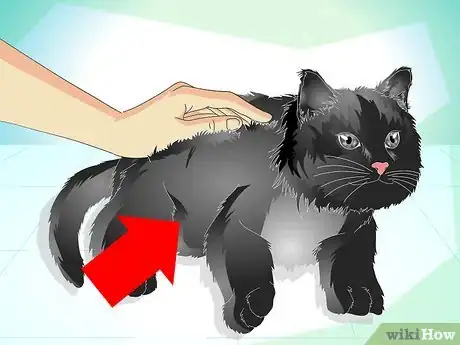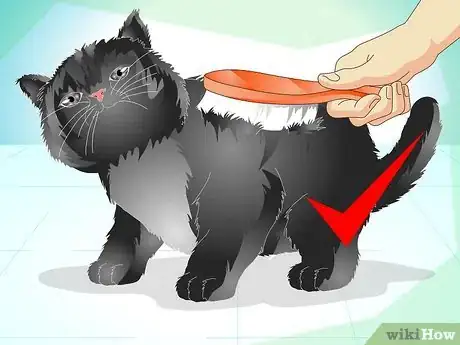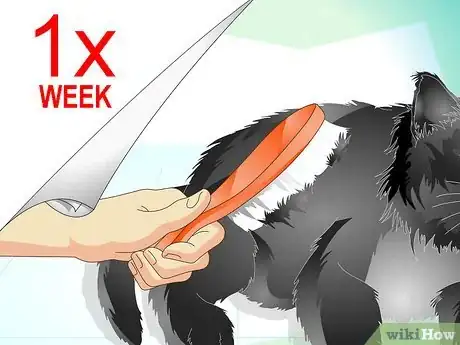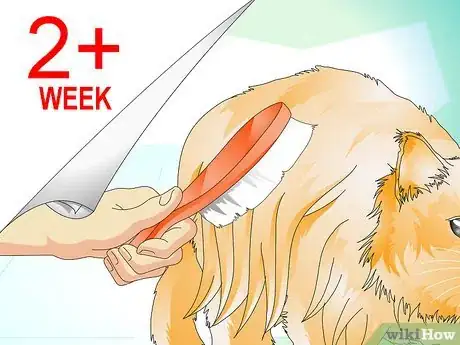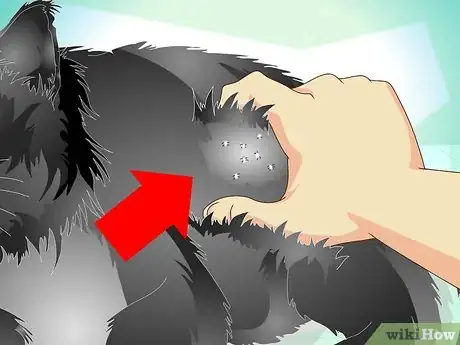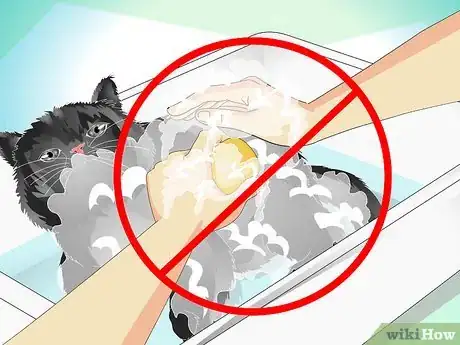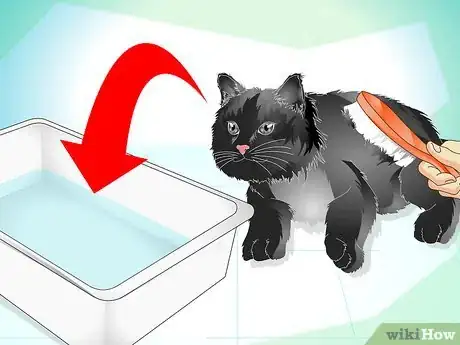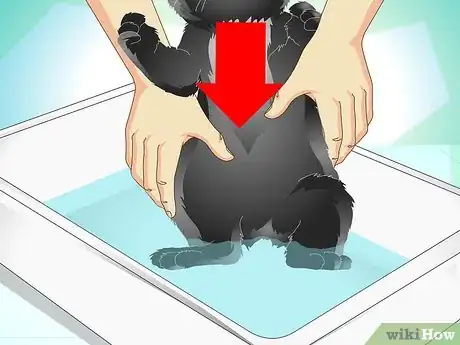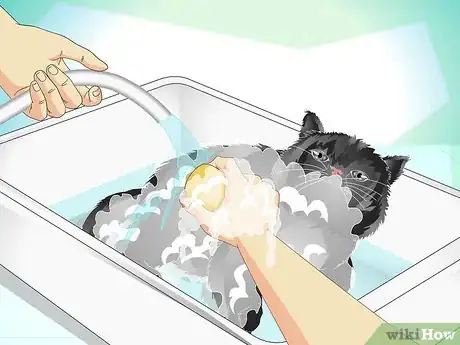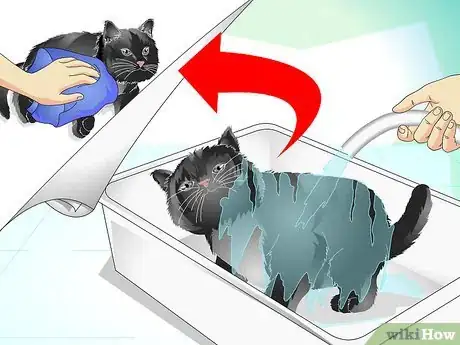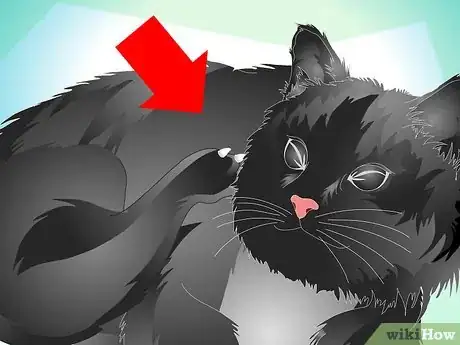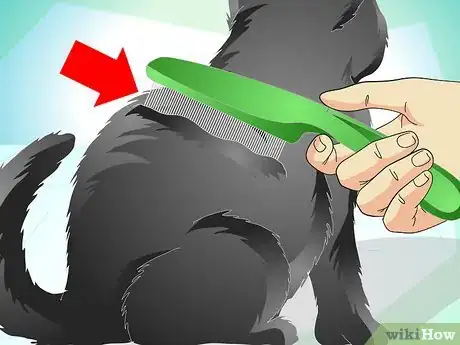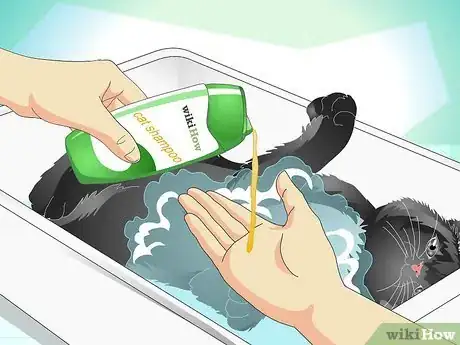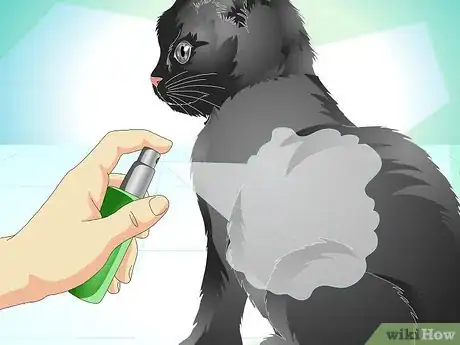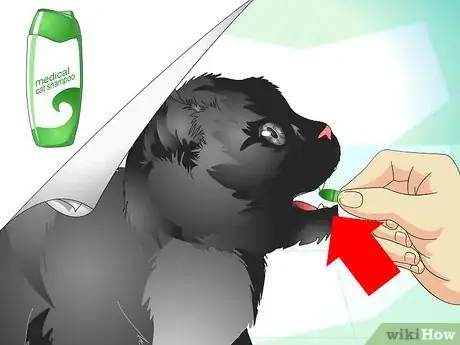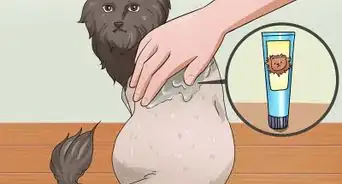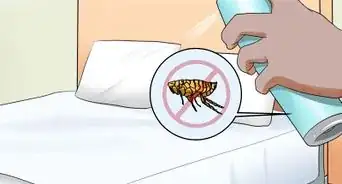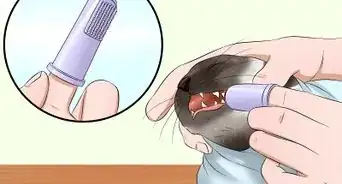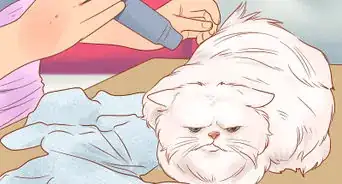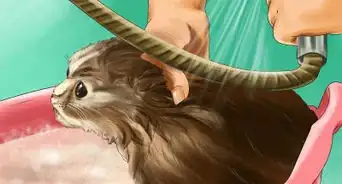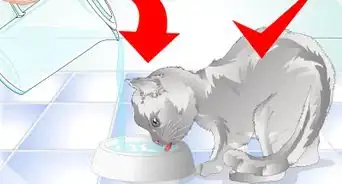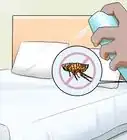This article was co-authored by Pippa Elliott, MRCVS. Dr. Elliott, BVMS, MRCVS is a veterinarian with over 30 years of experience in veterinary surgery and companion animal practice. She graduated from the University of Glasgow in 1987 with a degree in veterinary medicine and surgery. She has worked at the same animal clinic in her hometown for over 20 years.
There are 17 references cited in this article, which can be found at the bottom of the page.
This article has been viewed 34,490 times.
A cat’s coat is his crowning glory – and it can tell you a lot about his overall health, too. While cats are very tidy animals and do their best to keep clean, sometimes they need a little extra help. Periodically brushing, bathing, and checking your cat for fleas will reduce fur balls and keep his skin healthy and his coat full, shiny, and free from tangles.
Steps
Brushing Your Cat
-
1Check your cat’s coat often. A cat’s fur coat is a gauge of his overall health and should have a natural gloss and “spring.” However, dirt, oils, and other things can cause its condition to deteriorate.
- Give your cat a once-over 1 or 2 times a week. You shouldn’t find any bald patches, bumps, wounds, or signs of flea infestation.[1]
- Take note of any signs of an unhealthy coat. These include dryness, greasiness, dandruff, thinning hair, or a dull appearance.[2]
- Long-haired cats need extra attention because their coats tend to mat. Look for tangles when checking them.
-
2Make grooming a good experience. Since your cat needs occasional care, make sure that he is used to and enjoys being handled. Start slowly, be patient, and ensure that the experience is pleasant.[3]
- Only do grooming when your cat is in a good mood and relaxed, such as after exercise or feeding for the best results.
- Make sure that you are at ease, too! Try not to handle your kitty when you are stressed or in a bad mood, or he will associate grooming with aggression or fear.
- Keep your first sessions to 10 to 15 minutes until you get into a routine. Pet your cat all over so that he gets used to the attention – pet his head, ears, tail, feet, and belly.
- Be patient. Try again later if he is difficult and give him a treat after successful sessions.
Advertisement -
3Brush a short-haired cat once per week. Short-haired varieties like Bengals, American Shorthairs, and Abyssinians have less hair and don’t need as much attention. You can brush their coat once every week or perhaps even less.[4]
- First, take a metal comb and work through your cat’s fur from head to tail. This will dislodge dirt and other debris.
- Brush along the lie of a short-haired cat’s fur. In other words, go with the grain of the fur rather than against it. Brush all part of the cat’s body, focusing on one area at a time to loosen any tangles.
- Cats tend to be sensitive on the belly and chest. Be gentle when brushing there.
- Use a bristle or rubber brush next to remove loose or dead hair.
-
4Brush a long-haired cat more often. Long-haired breeds like Persians, Himalayans, and Balinese will need to be brushed more often than shorthairs. This is because their coats are more likely to mat and because they are more likely to get fur balls.[5] [6]
- Long-haired breeds need to be brushed every day or every other day, loosening tangles and removing dead hair. The more loose hair you remove, the fewer fur balls your cat will develop.[7]
- Start by brushing the cat’s belly and legs. Tangles tend to form in these areas especially, so be sure to untangle any knots there.
- Next, brush the whole cat’s body against lie of the fur with a bristle or rubber brush. Push the hair upward toward his head and, when you are finished, back down.
- To get the tail, make a part down the middle and brush the fur out on either side.
- Shake some talcum powder over difficult tangles and try to loosen them with your hands. Or, consider using a mat-splitter.[8] Severe mats should be removed by a professional groomer or your vet.[9]
-
5Feel and look for irregularities. During each grooming session, keep your eyes open and run your hands along the cat’s body to feel for things that shouldn’t be there. This is both for good grooming and for health.
- Feel for hidden tangles, but also for bumps or signs of ticks or fleas. Specks of blood can be a giveaway.
- Lift the cat’s tail and check its behind. You can cut away any fur that is matted with feces with scissors.
- Look particularly for tan, rice-sized objects near the anus. These are tapeworm segments and indicate that your cat has a tapeworm infection.[10]
Bathing Your Cat
-
1Don’t over-bathe. Cats self-clean and are usually more than able to take care of themselves. Your cat may need some extra cleaning if she’s gotten into something dirty or smelly, but you should usually limit her baths.[11]
- Bathing can dry out your cat’s skin. Frequent baths can also change the oil gland levels, which may worsen her coat condition.
- When you do give a bath, go easy on your pet by using mild, cat-safe shampoo.
-
2Use good sense and timing. Cats famously do not like water. That said, pick a time as with brushing when your cat is in an easy, relaxed mood. Often the best time is after some play or after a brush-down.
- Some groomers recommend trimming a cat’s claws before you bathe her, which can save you some pain if she does not take to the water.[12] You may also want to wear rubber gloves.
- Lay down a rubber mat in the sink or rub. This will help the cat keep her footing and prevent slipping.
-
3Draw the bath. You can use a plastic tub for the bath or a sink, depending on your cat’s size. Fill the basin with 2 to 3 inches (5.1 to 7.6 cm) of water. Then, carefully lift your cat and set her in the tub.[13]
- Make sure that the water is not too hot. It should be lukewarm and not uncomfortable to the touch.
- Don’t over-fill the basin with water. The cat should be standing (not swimming!) in the water.
-
4Wet and lather. Begin to wet the animal all over its body. You can use a spray hose if your sink has one. Otherwise, you might also try a spray bottle or even scoop water over the cat with a plastic pitcher.[14]
- Apply some shampoo to the cat’s coat and start to work up a lather. Massage the shampoo into her fur from head to her tail, avoiding the eyes and face.
- To ensure a mild solution, mix one part cat shampoo with five parts water.[15]
- Many cats do not like being splashed with water in the face. To avoid a tense situation, use a wet washcloth to clear your pet’s head.
-
5Rinse and dry. Once you’ve got a good lather, it’s time to rinse. Flush out the shampoo with plain water, again lukewarm, from a spray nozzle or pitcher. Be sure to get all of the solution as leftover shampoo can irritate the skin and attract dirt.[16]
- Wrap the cat in a large towel to dry and put her in a draft-free place.
- Long-haired cats will probably need a combing or brushing after a bath, to prevent tangles.
- Be sure to give your cat a treat after a bath to reinforce the experience. Reduce her anxiety and fear as much as possible.
Getting Rid of Fleas
-
1Look closely. Note any signs of movement on your cat’s fur or any changes in behavior, like frequent scratching. These and other factors can signal that he has a case of fleas.
- Flea bites feel itchy. A cat with fleas may scratch or bite at its coat frantically in an effort to get relief.
- Your cat might also groom more than usual, show hair loss, act agitated or restless, or have red lesions or bumps (bites marks).
- Fleas also leave feces, which will look like black pepper in your cat’s coat.
-
2Comb your cat with a fine-toothed comb. Find a metal, fine-toothed comb and slowly work your way through the cat’s coat. The combing will weed out fleas and relieve the cat’s itching somewhat.[17]
- The comb treatment will remove many of the fleas and their eggs. Dip the comb into a bowl of soapy water as you go, to get rid of them.
- Repeat the treatment in the following days until the animal is no longer infested.
-
3Wash the fleas away. Another option is to give your cat a bath and to flush the fleas out of the coat. Proceed like you are giving the animal a normal bath, but use a shampoo that kills fleas.[18]
- Fill a basin with a couple of inches of cool, soothing water and place the cat in it.
- Apply a shampoo, ideally one that is known to repel fleas like cedar, eucalyptus, lavender, or citrus.
- Some people also think that apple cider vinegar is effective in getting rid of fleas.[19]
- Comb the cat with a flea comb after the bath and repeat the process daily until the fleas are gone.
-
4Use spot treatment medication. Spot-on flea meds are pesticides and should get rid of a pesky flea infestation. Since cats clean themselves by licking, they are safer than sprays or dusts that have to be applied to the whole body.[20]
- Talk to your vet about spot-on products. She will be able to advise you and maybe provide a brand like Frontline, Advantage, and Stronghold/Resolution.
- Ask for instructions about how to use the product – where to put it, how often to apply it, and how much to use.
-
5Prevent future infestations. You cat is normal, healthy, and happy. Why worry about fleas or other parasites? Well, even a healthy cat can become a host. There are steps you can take to protect him from a future infestation.
- Give him periodic flea baths. There are medically treated shampoos that kill fleas on contact. You’ll have to re-bathe him about every two weeks.[21] However, keep in mind that flea shampoos will not protect your cat against fleas after your cat's coat has dried.
- Get your cat dewormed. Fleas are natural carriers of tapeworms. Your cat can easily swallow a flea infected with a tapeworm larva and end up with a bad case of worms.[22]
- Clean your house and carpet, especially if you are dealing with a bad case of fleas. Vacuum the floors, carpets, and furniture every day and wash sheets, fabrics, and covers that the pet touches at least once a week. Use hot water.[23]
Expert Q&A
-
QuestionWhy does my cat have so much dandruff?
 Pippa Elliott, MRCVSDr. Elliott, BVMS, MRCVS is a veterinarian with over 30 years of experience in veterinary surgery and companion animal practice. She graduated from the University of Glasgow in 1987 with a degree in veterinary medicine and surgery. She has worked at the same animal clinic in her hometown for over 20 years.
Pippa Elliott, MRCVSDr. Elliott, BVMS, MRCVS is a veterinarian with over 30 years of experience in veterinary surgery and companion animal practice. She graduated from the University of Glasgow in 1987 with a degree in veterinary medicine and surgery. She has worked at the same animal clinic in her hometown for over 20 years.
Veterinarian Dandruff or dry skin can happen if the cat has a dietary deficiency (doesn't eat a balanced diet), has difficulty digesting food (and doesn't absorb all the goodness) or doesn't groom properly. If the cat seems in someway off color, then you should get a vet check.
Dandruff or dry skin can happen if the cat has a dietary deficiency (doesn't eat a balanced diet), has difficulty digesting food (and doesn't absorb all the goodness) or doesn't groom properly. If the cat seems in someway off color, then you should get a vet check. -
QuestionCan you wash your cat?
 Pippa Elliott, MRCVSDr. Elliott, BVMS, MRCVS is a veterinarian with over 30 years of experience in veterinary surgery and companion animal practice. She graduated from the University of Glasgow in 1987 with a degree in veterinary medicine and surgery. She has worked at the same animal clinic in her hometown for over 20 years.
Pippa Elliott, MRCVSDr. Elliott, BVMS, MRCVS is a veterinarian with over 30 years of experience in veterinary surgery and companion animal practice. She graduated from the University of Glasgow in 1987 with a degree in veterinary medicine and surgery. She has worked at the same animal clinic in her hometown for over 20 years.
Veterinarian Yes, but be aware the cat might have other ideas. Unless a cat is used to baths, then they may take a dim view of getting wet and you could end up scratched or bitten. Try introducing water gradually, perhaps on a wet cloth. And make the water a comfortable temperature for the cat.
Yes, but be aware the cat might have other ideas. Unless a cat is used to baths, then they may take a dim view of getting wet and you could end up scratched or bitten. Try introducing water gradually, perhaps on a wet cloth. And make the water a comfortable temperature for the cat. -
QuestionHow can I clean my cat's fur?
 Pippa Elliott, MRCVSDr. Elliott, BVMS, MRCVS is a veterinarian with over 30 years of experience in veterinary surgery and companion animal practice. She graduated from the University of Glasgow in 1987 with a degree in veterinary medicine and surgery. She has worked at the same animal clinic in her hometown for over 20 years.
Pippa Elliott, MRCVSDr. Elliott, BVMS, MRCVS is a veterinarian with over 30 years of experience in veterinary surgery and companion animal practice. She graduated from the University of Glasgow in 1987 with a degree in veterinary medicine and surgery. She has worked at the same animal clinic in her hometown for over 20 years.
Veterinarian In most cases, combing through the coat will remove dirt or dust, without the need to bathe the cat. If the cat has one place that's smelly or dirty, then try wiping the area with a clean, damp facecloth or an unscented baby wipe.
In most cases, combing through the coat will remove dirt or dust, without the need to bathe the cat. If the cat has one place that's smelly or dirty, then try wiping the area with a clean, damp facecloth or an unscented baby wipe.
References
- ↑ https://www.aspca.org/pet-care/cat-care/cat-grooming-tips
- ↑ http://www.cat-world.com.au/Cat-Health-Collection/poor-coat-condition-in-cats.html
- ↑ http://pets.webmd.com/cats/guide/cat-grooming
- ↑ https://www.aspca.org/pet-care/cat-care/cat-grooming-tips
- ↑ http://pets.webmd.com/cats/guide/what-to-do-about-hairballs-in-cats
- ↑ http://pets.webmd.com/cats/guide/cat-grooming
- ↑ http://pets.webmd.com/cats/guide/what-to-do-about-hairballs-in-cats?page=2
- ↑ https://www.aspca.org/pet-care/cat-care/cat-grooming-tips
- ↑ http://icatcare.org/advice/how-groom-your-cat
- ↑ https://www.aspca.org/pet-care/cat-care/common-cat-diseases
- ↑ http://www.healthypawspetinsurance.com/blog/2012/06/25/common-illness-in-cats-coat-conditions/
- ↑ https://www.aspca.org/pet-care/cat-care/cat-grooming-tips
- ↑ http://www.catster.com/cat-health-care/how-to-give-a-cat-a-bath
- ↑ http://pets.webmd.com/cats/bathing-your-cat
- ↑ https://www.aspca.org/pet-care/cat-care/cat-grooming-tips
- ↑ http://pets.webmd.com/cats/bathing-your-cat
- ↑ https://www.worldsbestcatlitter.com/clearing-the-air/2015/09/five-ways-to-get-rid-of-cat-fleas-naturally/
- ↑ https://www.worldsbestcatlitter.com/clearing-the-air/2015/09/five-ways-to-get-rid-of-cat-fleas-naturally/
- ↑ http://everydayroots.com/flea-remedies-for-cats
- ↑ http://pets.webmd.com/cats/guide/flea-prevention
- ↑ http://www.petmd.com/cat/slideshows/parasites/10-ways-to-stop-biting-fleas-on-cats
- ↑ http://www.cdc.gov/parasites/dipylidium/faqs.html
- ↑ http://pets.webmd.com/cats/guide/flea-prevention?page=2
About This Article
To care for your cat's coat, start by brushing it once per week if you have a short-haired breed, and every other day if you have a long-haired breed. Work a metal comb through your cat’s fur from head to tail to dislodge dirt and other debris. Then, use a rubber or bristle brush to brush with the grain of the fur, focusing on one area at a time. If you have a long-haired kitty, follow up by brushing its entire body again, this time against the grain of the fur. Finally, lift the cat’s tail and check its behind for matted fur. If you see any, gently cut away the mats with scissors. For tips from our Veterinary co-author on bathing your cat, read on!
